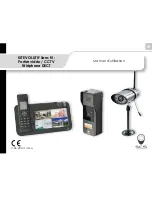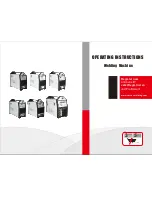
Install instructions for TEATRO Soundbar models, Page 2
!
FLAT PANEL WALL MOUNT
ATTACHMENT INSERTS
USE THESE SETS OF HOLES
FOR SPEAKER BRACKETS FOR
NORMAL WALL MOUNTING
Figure 1
WALL MOUNT
BRACKETS
STAND-OFF BUMPER
LOCK NUT, WASHER
SPEAKER MOUNTING BRACKETS
HOOK INTO WALL BRACKETS
SPEAKER MOUNT
BRACKETS
Measure your flat panel display horizontally and find the center
(width). The brackets should be positioned 5” either side of this center
line. Using the mounting bracket as a guide, measure 1 ½” from the
bottom of the display to the top edge of the bracket and 5” over from
the center line to the bracket edge (see Fig. 1). This will allow about a
¼” space between the bottom of the display and the speaker cabinet.
This spacing can be adjusted to suit personal taste or applications as
necessary. Use a level to make sure the mounting bracket is straight.
With the bracket positioned in the desired location use a pencil to
mark at least four mounting holes on the wall for the bracket mount-
ing screws. Try to have at least 2 holes on each bracket that line up
over a wall stud. Drill the wall, install your anchors and fasten the
brackets to the wall with the “J” bend at the bottom (fig. 2 & 3).
Step 3
Place your TEATRO sound bar speaker face down on a soft clean
surface with the grille on. Orient the speaker so the input terminal is
on the left hand side. The second pair of steel brackets supplied with
the speaker is designed to attach to the threaded inserts on the rear of
the speaker cabinet with the eight supplied #10-32x3/8” Philips
screws. Align the holes on the brackets with the center and bottom set
of mounting holes on the rear of the speaker. Position the brackets
similar to the ones mounted on the wall with the “J” bend up so it can
hook into the wall bracket. Attach brackets to the rear of the speaker
using four screws per bracket (Fig. 1 & 2).
Install one each of the 6, #10-32x1” Phillips screws in the threaded nut
located in the bottom center of the “J” bend of the two wall mounted
brackets. These screws are for leveling the speaker. Start the screws,
but do not screw in at this time.
Install the other four 1” screws in the end mounted nuts of the cabinet
mounted brackets. These are the bracket locking screws and should
be installed so they can be adjusted from the bottom of the speaker
(Fig. 3 next page).
Assemble the two rubber stand-off bumpers next. Thread one nut
onto each bumper stand-off and then one nylon washer. Run the nut
about halfway down the screw. Thread each of the bumper stand-offs
into the two lower inserts located on the bottom rear edge of the
cabinet (Fig. 2).
Figure 2
Step 4
There are three pair of gold binding post terminals on the rear of the
speaker cabinet. The terminals are marked for Right Input, Center
Input and Left Input and should be connected to the respective
speaker channel outputs on your receiver. Connect the speaker wires
to the correct terminals observing the polarity indicated on the
terminal. Red is + or positive and black is – or negative. Strip about ½”
of insulation from the wires and separate the wires as necessary. If you
are using other wire lugs or connectors, attach them at this time to the
bare wire. Unscrew the binding post terminals and slip the stripped
end of the wire through the hole in the metal post. Secure the wire in
the post by tightening the binding post terminal nut down on the
bare wire or lug. Make sure the nut is tight and the wire will not pull
out of the terminal by lightly pulling back on the wire. Tuck the
speaker wire in behind the speaker cabinet; if necessary, neaten up
the wire with the use of tie wraps.
8 3/16”
8005 W. 110th St., Suite 208 / Overland Park, KS 66215 / (888)PHASE TK / www.phasetech.com / www.mseaudio.com






















